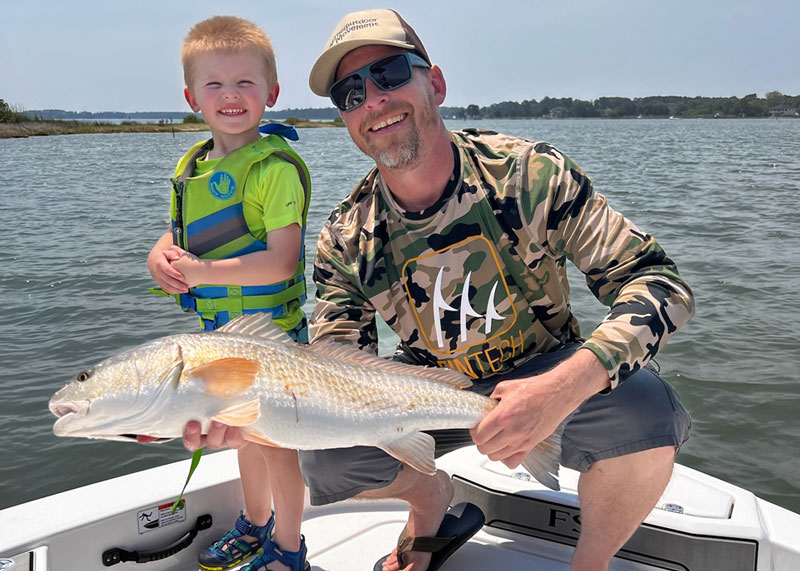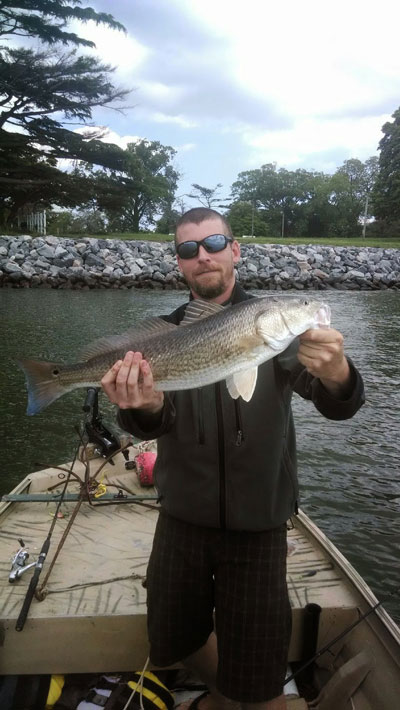Red Drum in skinny water can be some of the most action-packed fishing you can find on the lower Chesapeake Bay during the late summer and early fall months — this month is the perfect time to get out on your local waters and target these brutes. Redfish can be caught in a variety of ways but my go to method is targeting them on the flats, in various river systems, and in the creeks. If you can find aquatic grass beds located in clean water, you will no doubt find drum close by.

Redfish, Where?
While speckled trout tend to hang further off the shoreline, drum love to stack up along marshy points, rock piles, and jetties along creeks to pick off crabs and baitfish that hang close by for cover. The key to targeting schools of puppy drum is to move around until you locate the fish. I will spend 15 to 20 minutes in a spot and if it doesn’t produce, move on and try a new location. These fish are vacuum cleaners when it comes to feeding and usually are more than willing to eat — so you will know quickly whether they are in that particular spot or not. These fish tend to be slot reds in the 18- to 26-inch range although the occasional trophy bull does find its way into the mix regularly as well. By nature, these heavy fighters are a schooling species so when you do find one it’s usually not alone; oftentimes you will see two or three companions follow the fish you are fighting right up to the boat. So, make sure to thoroughly work an area once you hook into one.
As far as water depth, focus your search on troughs and deeper holes in skinny water. This could be a slough that is four to five feet deep surrounded by one- to three-foot-deep water in all directions. It would be a disservice to not mention these fighters will also readily congregate along ledges or drop offs on the edge of said flats as well in slightly deeper areas. Here on the lower Chesapeake some of my best spots are where depth changes quickly from those one- to three-foot-deep flats and drop off a channel ledge to up to 10 feet of water or more. These locations provide a great place to ambush their prey and pick off easy meals especially when feeding on blue crabs. These deeper waters tend to be cooler which adds to their appeal in the hottest part of the year. As a bonus, you will tend to catch some stud speckled trout sharing these same areas in the summer months as well.
Redfish, How?
Lure selection for drum can come in all shapes and sizes based on the techniques used and the conditions on the water that day, so I will go over quite a few. If you plan to cover water, casting topwater baits and jigheads with soft plastics is the ticket as long as there is not a ton of surface debris and grass floating about. This provides you the ability to pick apart an area quickly and dial in on the location of the fish. Fair warning, the explosions these fish make on a topwater lure can rival the biggest bass blowups you’ve ever seen and are highly addictive. For soft plastic baits, don’t be afraid to go big. I have found six-inch imitation shad in the guts of fish before. I prefer to use my hand-poured four-inch swimbaits, but all your favorite varieties of Gulp! will work magic as well.

Another proven technique that originated down south and has really taken off on the Bay in the last five years is using popping corks. This approach will keep your bait off the bottom helping dodge some of the rays which love to destroy baited bottom rigs. A popping cork makes a clacking sound when given a quick tug and really does draw in the drum bite, too. I like to use 30-pound fluorocarbon leader roughly 18- to 24-inches long depending on water depth, and terminate to a 3/0 to 5/0 circle hook. Bull minnows, peeler crabs, and just plain hard crabs quartered will almost always do the trick. The cork can be cast and popped along as you go, fanned out around an anchored vessel, or left in a rear rod holder while drifting along casting other baits, making it a great rod setup to keep in the boat on any trip. This also happens to be an amazing setup if you have kids in the boat as the visual indicator of a cork getting sucked below the surface will no doubt get their hearts racing.
Last but not least are casting spoons. While I haven’t seen many people fishing them in my circle as much lately, a gold Johnson spoon is notorious for catching drum and has been proven over the last 20 years as a staple in the tackle box. These also come in a weedless design which is worth its weight in gold when you find yourself in an area with copious amounts of eel grass.
If you can find a place that intersects a transition from one drum spot to the next, anchoring off and soaking peeler crab can produce a cooler full of fish as well. I usually reserve this tactic for a time after I have really figured out their pattern over several trips out.
Fishing for red drum on the flats and around your local creeks can provide for some much-needed action on those dog days of late summer and early fall. It doesn’t require large vessels or full day trips to get in on some amazing fishing, so get out there, put in a little time exploring your local waters, and you will most likely find a great bite closer by than you expect.
-By Blair Hansford